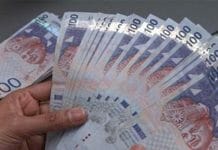By Dr Mohd Afzanizam Abdul Rashid, Chief Economist, Bank Islam Malaysia Berhad
The sharp rise in the US Treasury recently has served as a reminder to us that is the stark contrast between the policy rates and how the market perceived of how the interest rates should evolve going forward. The 10-year US Treasury yields which is the barometer for the future interest rates have lept to 1.74 percent as of 19 March from 0.91 percent in the early part of January. Understandably, the incoming data from the US economy has been quite decent with total jobs created or the Nonfarm payroll (NFP) jumping to 379,000 in February against the median estimates of 182,000.
Similarly, business sentiments as indicated by the Institute for Supply Management (ISM) for manufacturing industries have also traversing the 60.8 points during February, signaling more businesses are feeling upbeat about the state of the economy. The ISM’s demarcation line of 50 points separates those who are optimistic (>50) and pessimistic (<50). Essentially, is the businesses assessment of their business affairs such as their new orders, product pricing, employment and how all this parameters stack up with the present state of the economy.
While the bond markets may have their own verdict, the policy makers are leaning towards keeping the rates low. Such notion does make sense as the pace of economic recovery is greatly hinged upon the successful rollout of the Covid-19 and how soon the global economy would achieve the so-called herd immunity. Not to mention the reservation towards the vaccine among the general public as some may not be comfortable to receive the vaccine jabs for fear of their own safety. Therefore, the downside risks to growth will remain visible and the central bank will continue to be data dependent whenever they want to decide their next course of action.
There appears to be a tug of war between the bond markets and the US Fed. It does feel a reminiscence of the “taper tantrum” episode back in May 2013. At that point in time, the former Fed Chairman Ben Bernanke was delivering his testimony to the US Congress on 22 May 2013 when he spoke about the possibility of reducing the bond buying program or better known as Quantitative Easing (QE). This happened as there were emerging signs of economic recovery after the country experiencing a severe decline in economic activities following the Subprime Crisis in 2007 and 2008.
The 10-year US Treasury bonds yielded higher from 1.94 percent on 21 May 2013 to near 3.00percent level by September during that year. The sharp rise in bond yields were supported by the economic fundamentals with the monthly NFP averaging around 192k in 2013 against 181,000 and 173,000 in 2012 and 2011 respectively. The unemployment rate has also fallen from as high as 10 percent in October 2009 to 6.7 percent by the end of 2013. The Malaysian Government Securities (MGS) market had also exhibited the same trend when the 10-year MGS yields rose from 3.16percent on 21 May 2013 to more than 4.00percent by September during that year. So it is systemic.
In that sense, signals from the bond markets should never be ignored. There are reasons as to why the bond market participants are behaving in such as a way. The recent tell-tale signs also indicate that the economic recovery is underway but at the same time, the pattern is likely to be disproportionate as the speed of the vaccine rollout varies from one country to the other.
That would make the signals can be blurry as the markets would tend to be more volatile as the economic data can be fudgy. Therefore, deciding what is the right asset class to invest during these uncertain times can be extremely challenging. Typically, the fixed income fund managers would want to reduce their portfolio duration as the longer term bonds will be the most susceptible when the interest rates are expected to go up given the inverse relationship between the cost of borrowings and the bond prices. Equities would seem to be the highly sought-after choice as companies’ earnings are anticipated to turn around after experiencing large decline or even losses when the economy suffers from the worst recession last year.
It’s always a dilemma of investing, making the right choice or rather, the right balance between the two asset classes. Henceforth, the best defense is diversification and a well-balanced portfolio alongside with strong holding power and patience.









